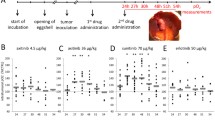Abstract
Carboxyamidotriazole (CAI), an inhibitor of calcium-mediated signal transduction, is a promising new cytostatic anti-cancer drug which has entered Phase II clinical trials, and for which multiple modes of action have been proposed. We tested the hypothesis that CAI can inhibit tumor angiogenesis in vivo. The ability of orally administered CAI to inhibit experimental metastases of B16F1 melanoma cells in mouse liver was assessed. A computer-assisted stereological technique was then used to analyze images from histological sections of CAI-treated vs. control livers; the vascular volume percentage (percentage of tumor volume consisting of functional microvessels) was determined to assess the effect of CAI on tumor angiogenesis. CAI treatment significantly reduced the size (8 × reduction in volume; P = 0.02) but not the number of metastases. In association with this reduction in tumor size, CAI significantly decreased the vascular volume percentage within metastases by at least a factor of two (P = 0.001). A reduction in both number of microvessels/mm2 and microvessel size (cross-sectional area) was found to contribute to this decrease. CAI treatment did not affect the vascular volume percentage of normal liver tissue surrounding metastases (P = 0.8). This study documents for the first time that CAI can inhibit tumor angiogenesis within metastases in vivo.
Similar content being viewed by others
References
Folkman J. Tumor angiogenesis: Therapeutic implications. N Engl J Med 1971; 285, 1182–1186.
Liotta LA, Kleinerman J, Seidel GM. Quantitative relationships of intravascular tumor cells, tumor vessels, and pulmonary metastases following tumor implantation. Cancer Res 1974; 34, 997–1004.
Folkman J. Angiogenesis in cancer, vascular, rheumatoid and other disease. Nature Med 1995; 1, 27–31.
Zetter BR. Angiogenesis and tumor metastasis. Annu Rev Med 1998; 49, 407–424.
Kohn EC, Liotta LA. L651582: A novel antiproliferative and antimetastasis agent. J Natl Cancer Inst 1990; 82, 54–60.
Felder CC, Ma AL, Liotta LA, Kohn EC. The antiproliferative and antimetastatic compound L651582 inhibits muscarinic acetylcholine receptor-stimulated calcium influx and arachidonic acid release. J Pharmacol Exp Ther 1991; 257, 967–971.
Hupe DJ, Bolez R, Cohen CJ, et al. The inhibition of receptor-mediated and voltage-dependent calcium entry by the antiproliferative L-651,582. J Biol Chem 1991; 266, 10136–10142.
Kohn EC, Sandeen MA, Liotta LA. In vivo efficacy of a novel inhibitor of selected signal transduction pathways including calcium, arachidonate, and inositol phosphates. Cancer Res 1992; 52, 3208–3212.
Kohn EC, Figg WD, Sarosy GA, et al. Phase I trial of micronized formulation carboxyamidotriazole in patients with refractory solid tumors: pharmacokinetics, clinical outcome, and comparison of formulations. J Clin Oncol 1997; 15, 1985–1993.
Christian MC, Pluda JM, Ho PTC, et al. Promising new agents under development by the Division of Cancer Treatment, Diagnosis, and Centers of the National Cancer Institute. Sem Oncol 1997; 24, 219–240.
Kohn EC, Felder CC, Jacobs W, et al. Structure-function analysis of signal and growth inhibition by carboxyamido-triazole, CAI. Cancer Res 1994; 54, 935–942.
Kohn EC, Alessandro R, Spoonster J, et al. Angiogenesis: role of calcium-mediated signal transduction. Proc Natl Acad Sci USA 1995; 92, 1307–1311.
Chambers AF, MacDonald IC, Schmidt EE, et al. Steps in tumor metastasis: new concepts from intravital videomicroscopy. Cancer Metastasis Rev 1995; 14, 279–301.
Koop S, Schmidt EE, MacDonald IC, et al. Independence of metastatic ability and extravasation: Metastatic ras-transformed and control fibroblasts extravasate equally well. Proc Natl Acad Sci USA 1996; 93, 11080–11084.
Fidler IJ. Selection of successive tumor lines for metastasis. Nature 1973; 242, 148–149.
Koop S, MacDonald IC, Luzzi K, et al. Fate of melanoma cells entering the microcirculation: over 80% survive and extravasate. Cancer Res 1995; 55, 2520–2523.
Morris VL, MacDonald IC, Koop S, et al. Early interactions of cancer cells with the microvasculature in mouse liver and muscle during hematogenous metastasis: videomicroscopic analysis. Clin Exp Metastasis 1993; 11, 377–390.
Wylie S, MacDonald IC, Varghese HJ, et al. The matrix metalloproteinase inhibitor batimastat inhibits angiogenesis in liver metastases of B16F1 melanoma cells. Clin Exp Metastasis 1999; 17, 111–117.
Weibel ER. Volume 1: Practical methods for biological morphometry; and Volume 2: Theoretical foundations. In: Stereological Methods. New York: Academic Press, 1979 (Vol. 1), 1980 (Vol. 2).
Barbareschi M, Weidner N, Gasparini G, et al. Microvessel density quantification in breast carcinomas. Assessment by light microscopy vs. a computer-aided image analysis system. Appl Immunohistochem 1995; 3, 75–84.
Chosay JG, Fisher MA, Farhood A, et al. Role of PECAM-1 (CD31) in neutrophil transmigration in murine models of liver and peritoneal inflammation. Am J Physiol 1998; 274 (Gastrointest Liver Physiol 37), G776–G782.
Booth CJ, Sundberg JP. Hemangiomas and hemangiosarcomas in inbred laboratory mice. Lab Animal Sci 1995; 45, 497–502.
Tanigaki Y, Saeki Y, Matsuhisa T, et al. Antiangiogenic substance(s) in a tumor cell line with low metastatic potential originating from the BALB/c mouse liver. Invasion Metastasis 1995; 15, 70–80.
Lenzi R, Alpini G, Liu MH, et al. Von Willebrand factor antigen is not an accurate marker of rat and guinea pig liver endothelial cells. Liver 1990; 10, 372–379.
Author information
Authors and Affiliations
Rights and permissions
About this article
Cite this article
Luzzi, K.J., Varghese, H.J., MacDonald, I.C. et al. Inhibition of angiogenesis in liver metastases by carboxyamidotriazole (CAI). Angiogenesis 2, 373–379 (1998). https://doi.org/10.1023/A:1009259521092
Issue Date:
DOI: https://doi.org/10.1023/A:1009259521092




